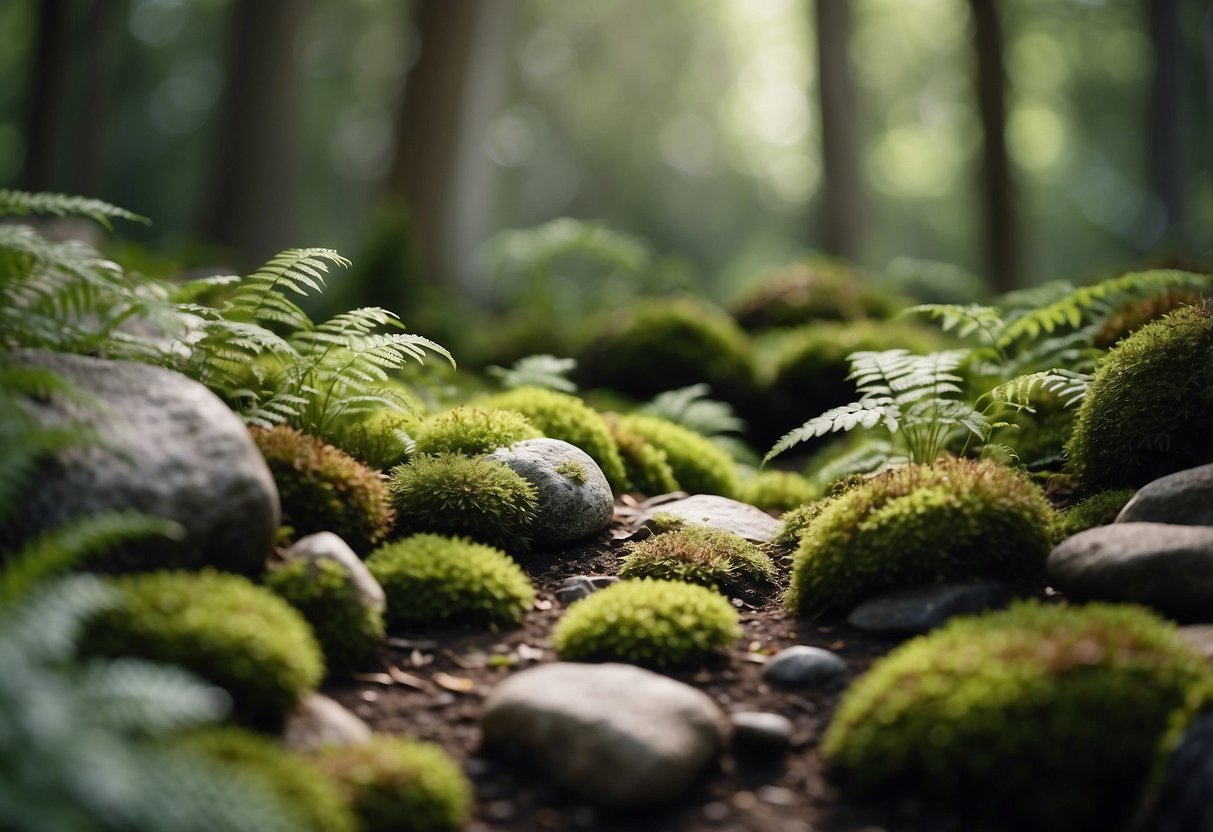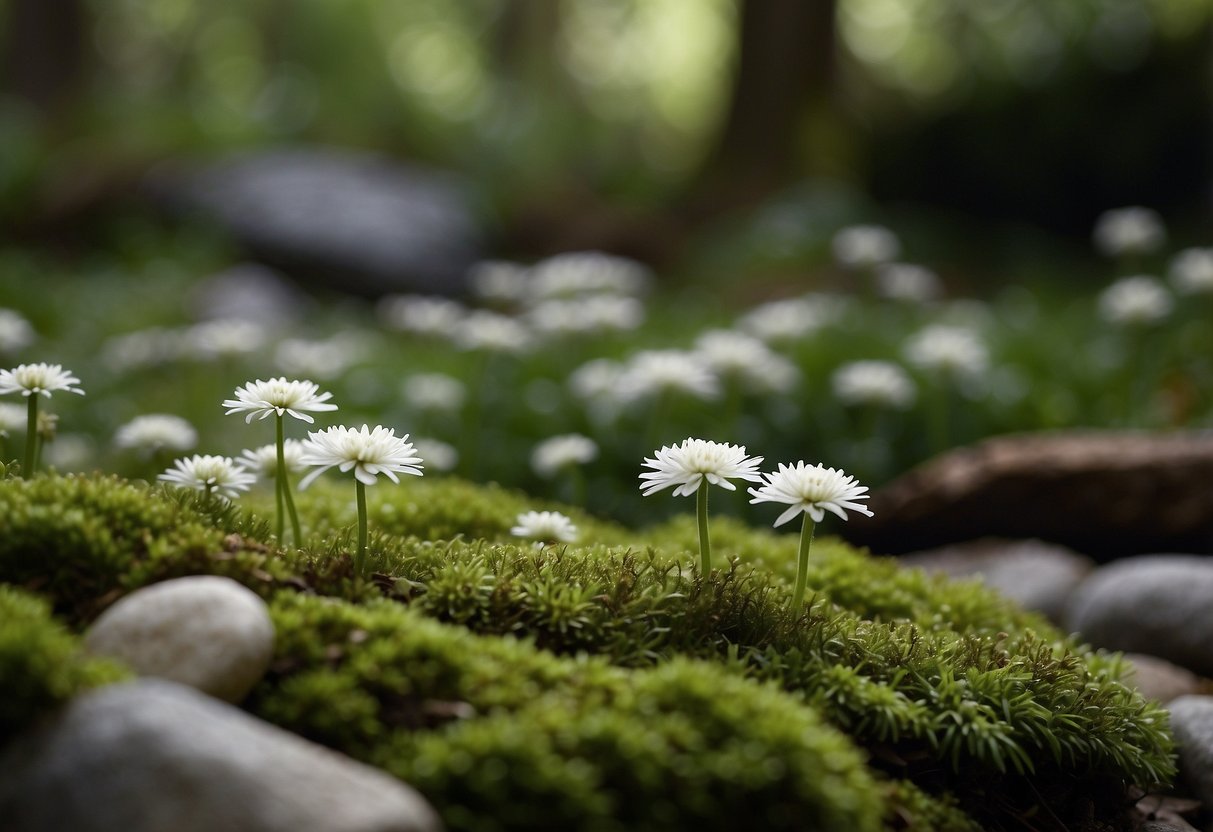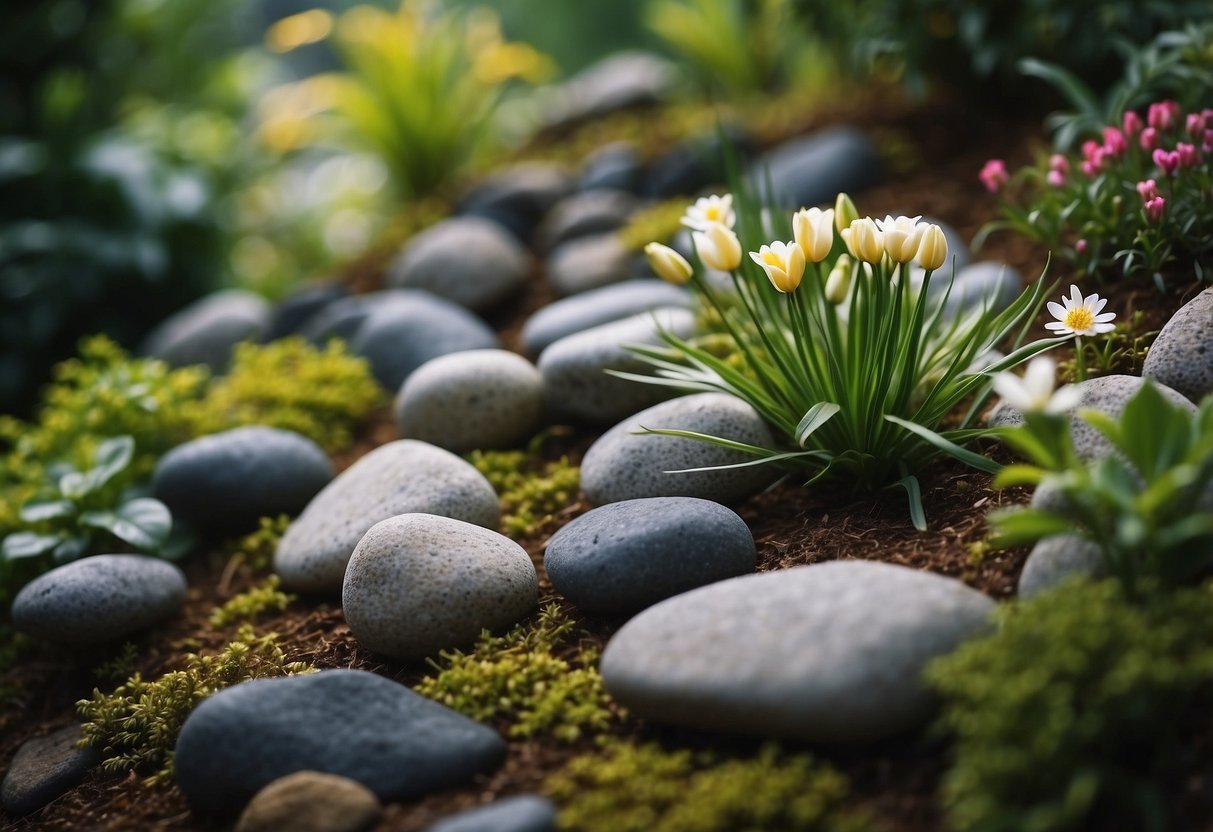Rock Garden Ideas Shade: Creative Designs for Your Shady Spots
Creating a rock garden in a shady area can be a beautiful and rewarding landscaping project. Whether your yard is naturally shady or you want to add some variety to a sun-drenched space, shade-tolerant plants and carefully placed rocks can bring texture and color to your garden. How can you make the most of a rock garden in a shaded spot?

Designing a rock garden for shade involves selecting the right plants and ensuring good drainage. When done thoughtfully, your garden can become a peaceful retreat with unique visual appeal. From ferns and mosses to shade-loving flowers and ground covers, there are plenty of options to explore.
1) Hostas

Hostas are a great choice for your rock garden. They love the shade and can thrive in well-drained soil. These plants are known for their large, attractive leaves.
With over 70 species and 3,000+ hybrids, you have a lot of options. Hostas work well with other shade-loving plants like ferns and astilbes.
To make your garden even more interesting, you can combine hostas with rocks of different sizes and textures. This creates a natural and appealing look.
Hostas need minimal care. Water them regularly and remove any dead leaves to keep them healthy and vibrant.
2) Japanese Painted Fern

Japanese Painted Fern shines in shaded rock gardens. Its silvery fronds with purplish midribs bring color and elegance to your space.
This fern loves very acidic soil and can grow in deep shade. It reaches a height of 12 to 18 inches and spreads about 24 inches wide.
For a stunning display, consider placing the ferns about 24 inches apart and keeping the soil evenly moist. Learn more about growing Japanese Painted Ferns here.
3) Lungwort

Lungwort is a fantastic choice for shaded rock gardens. This plant thrives in zones 3-9 and prefers partial to full shade.
Its flowers bloom in clusters of pink or white, darkening as they age. These flowers are favorites of hummingbirds and bees.
Lungwort also offers stunning foliage, with green leaves spotted or speckled with white. It’s a visual treat for your garden. For more details, check out Easy Shade Gardening.
4) Coral Bells

Coral Bells are a fantastic addition to your shade rock garden. They have vibrant, colorful leaves that come in shades of red, purple, and green. These plants can brighten up any shady area.
Coral Bells grow best in partial shade. They need at least 4-6 hours of sunlight each day to thrive. These hardy plants are also heat-tolerant and grow well in various soil types, including clay and rocky soils.
Their flowers attract butterflies and hummingbirds. Plant Coral Bells in masses to create striking color contrasts and make your garden come alive. For more details, check out Proven Winners’ guide.
5) Astilbes

Astilbes are a fantastic choice for shady rock gardens. They bring a burst of color with their fluffy, plume-like flowers.
Astilbes thrive in shady areas, making them perfect for spots where other plants struggle. You can choose from a variety of colors like pink, white, and purple.
Their fern-like leaves add texture to your garden. Plant them in groups for maximum impact. Astilbes need moist, well-drained soil, so be sure to water them regularly.
6) Foamflower

Foamflower is a lovely addition to your shady rock garden. Its star-shaped blooms add a whimsical touch, looking like delicate foam on a green backdrop.
Foamflower thrives in shady areas and needs rich, moist soil. It’s a hardy perennial that can grow up to 12 inches tall.
For the best results, plant Foamflower in spots with some shade and consistent moisture. Think areas under trees or alongside native shrubs.
7) Bleeding Heart

Bleeding Heart is a charming plant known for its heart-shaped flowers. These flowers hang gracefully from arching stems, adding elegance to your rock garden.
This plant thrives in shade and prefers well-drained soil. It is native to Asia and North America, making it hardy and reliable.
Blooming occurs from late spring to early summer. The unique flowers of Bleeding Heart can really brighten up shady spots in your garden. Learn more about growing Bleeding Heart here.
8) Solomon’s Seal

Solomon’s Seal is a beautiful plant perfect for your rock garden’s shady spots. It has arching stems that give it an elegant look. In the spring, you’ll notice small, white bell-shaped flowers that add charm to your garden.
The plant’s deep green leaves turn yellow in the fall, offering seasonal interest. You can learn more about this stunning plant here.
It’s a versatile plant that thrives in well-drained, moist soil, making it a great addition to your shade-loving rock garden.
9) Dead Nettle

Dead Nettle is perfect for adding color to your shaded rock garden. It loves shade and is easy to grow. You’ll enjoy its colorful foliage and long-lasting flowers.
This plant can create a vibrant carpet in shady areas. Be aware, though, that some types can spread quickly. Choose companions like Coral Bells or Cyclamen to create a stunning look.
Want more information? Check out this guide on growing Dead Nettles.
10) Hakone Grass

Hakone Grass, also known as Japanese Forest Grass, adds elegance to any shaded rock garden. Its flowing, bamboo-like blades create a lush, green carpet that drapes gracefully over rocks.
Growing best in part shade, Hakone Grass needs consistently moist, well-drained soil. You can use it for ground cover, edging, or even in containers to brighten up shaded corners.
For the best color, some light exposure helps. This adaptable plant can thrive in different settings and bring texture and visual interest to your rock garden. For more on plant combinations, visit Gardenia.
Benefits of Rock Gardens in Shaded Areas

Rock gardens in shaded areas offer unique advantages such as requiring less maintenance, conserving water, and providing year-round interest due to diverse plant choices suited for low-light conditions.
Low Maintenance
A rock garden in the shade is ideal if you want a low-maintenance garden. Plants suitable for shaded rock gardens usually require minimal pruning and care. Grass and weeds are less likely to grow in shaded areas, reducing the need for constant weeding. Many of the plants used are slow-growing, which means you won’t have to trim them often.
Shade-tolerant plants like ferns, hostas, and heucheras thrive with little attention. Once established, these plants require less frequent watering and fertilizing. The rocks themselves also play a vital role by protecting the soil from erosion and helping to maintain a stable environment for plants to grow. This combination makes your garden both beautiful and manageable.
Water Conservation
One of the main benefits of shaded rock gardens is their ability to conserve water. Plants that grow well in these gardens, such as certain ferns and hostas, generally need less water once they are established. The rocks help retain moisture in the soil, reducing the need for frequent watering.
Soil pockets created between rocks also aid in better water retention. Using a mix of sand, peat, and loam helps the soil drain well while still holding enough moisture for plant health. This is particularly beneficial in areas where water conservation is essential. With a well-designed rock garden, you can enjoy a lush, green space without spending a lot of time and resources on watering.
Year-Round Interest
Shaded rock gardens can be eye-catching all year long. By carefully choosing plants, you can have a garden that looks beautiful in every season. For instance, evergreens and certain grasses keep their color throughout the year, adding constant greenery to your space.
Plants with different textures, such as the blue-tinted foliage of blue fescue or the large leaves of hostas, provide visual interest even without flowers. In the spring and summer, you can add seasonal blooms like wild tulips and narcissus to bring bursts of color. During the fall, colorful foliage can add a new layer of charm. In winter, the structure of the rocks and evergreens continues to provide a striking visual appeal.
Choosing the Right Rocks for Shade Gardens

Selecting the appropriate rocks for your shade garden can enhance its natural beauty and create a harmonious environment. Opt for stones that blend well with the plants and the garden’s overall theme.
Natural Stone Options
For shade gardens, consider using granite, limestone, and sandstone. These types of rocks are durable and have varying textures and colors that can complement the greenery.
Granite provides a rugged look and comes in various shades such as gray, pink, and black, making it versatile.
Limestone is softer and often features subtle colors like white and beige, which can brighten shady spots.
Sandstone offers warm tones like red and brown and has a unique layered appearance that adds depth.
Using different sizes and shapes of these stones helps create a more natural, organic look in your garden. Position larger stones as focal points and scatter smaller stones to fill gaps.
Sourcing and Sustainability
When sourcing rocks, consider their environmental impact. It’s important to gather stones responsibly to avoid damaging ecosystems.
If possible, use rocks that are locally sourced to reduce transportation emissions and support local businesses. You can often find suitable rocks near riverbanks, forests, or beaches.
Recycled materials such as broken concrete can also be used creatively to mimic natural stone.
Avoid taking stones from protected areas or places where removal could cause harm to wildlife habitats. Look for suppliers that engage in sustainable practices, ensuring that the stones are ethically sourced.
By paying attention to sourcing and sustainability, your shade rock garden will not only look beautiful but also respect the environment.
Ideal Plant Choices for Shaded Rock Gardens

Choosing the right plants is crucial for a shaded rock garden. You need to look for plants that thrive in low light and can handle the unique conditions of a rock garden.
Shade-Tolerant Ferns
Ferns are a great choice for shaded rock gardens. They thrive in low light and add a lush, green texture. Some popular varieties include the Japanese Painted Fern and the Lady Fern. These ferns can tolerate moist soil, which is common in shaded areas.
Placing ferns among rocks allows their delicate fronds to contrast beautifully with the rugged landscape. Make sure the soil is well-drained to prevent root rot.
Ground Covers and Mosses
Ground covers and mosses are excellent for filling gaps between rocks. Creeping Thyme and Irish Moss are popular choices. These plants spread quickly and create a lush carpet of green, which helps control erosion and keep weeds at bay.
Mosses thrive in damp, shaded spots and add a soft, lush feel to your garden. They are low-maintenance and require little more than regular watering in dry periods.
Evergreen Shrubs
Evergreen shrubs like Boxwood and Azaleas provide structure and year-round interest. Boxwood is hardy and easy to shape, while Azaleas offer beautiful blooms in spring. Both can tolerate some shade and add a touch of color and height to your rock garden.
Ensure they have well-drained soil and occasional watering. These shrubs act as focal points and provide a sense of permanence to the garden.







